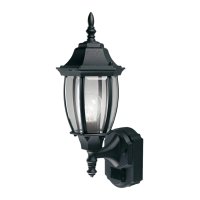Motion Sensing
Diecast Lantern
HB-4190 Series
Features
• Light comes on when motion is detected.
• Automatically turns light off.
• Dusk Accent lighting.
• Photocell keeps the light off during daylight
hours.
Requirements
• The light control requires 120 volts AC.
• If you want to use Manual Mode, the control
must be wired through a switch.
• Some codes require installation by a
qualified electrician.
© 2008 595-5770-05
OPERATION
* resets to Auto Mode at dawn.
Set the ON-TIME switch
on the bottom of the cover
plate to TEST.
TEST 1 5 10 MIN
Set ON-TIME switch to 1,
5 or 10 minutes.
1 Second
OFF then...
Manual mode only works at
night because daylight re-
turns the sensor to AUTO.
Flip the light switch off for
one second then back on to
toggle between AUTO and
MANUAL MODE.
Manual mode works only with
the ON-TIME switch in the 1,
5, or 10 position.
... back on.
Mode Switching Summary
D
ualBrite
®
Dimmer Control
Light comes on half bright for selected time
after dusk (3 hr., 6 hr., until dawn). If motion
is sensed, the light turns on full bright for the
ON-TIME (1, 5, or 10 minutes) then returns
to dim mode.
This package includes:
• Lantern
• Easy to use universal mounting bracket
(X-Bar)
• Mounting hardware
• Wire nuts
• Light Bulb(s)
ON-TIME Switch at 1,
5, or 10 minutes
Flip light switch
off for one second
then back on*
* If you get confused while switching modes,
turn the power off for one minute, then back
on. After the calibration time the control will
be in the AUTO mode.

